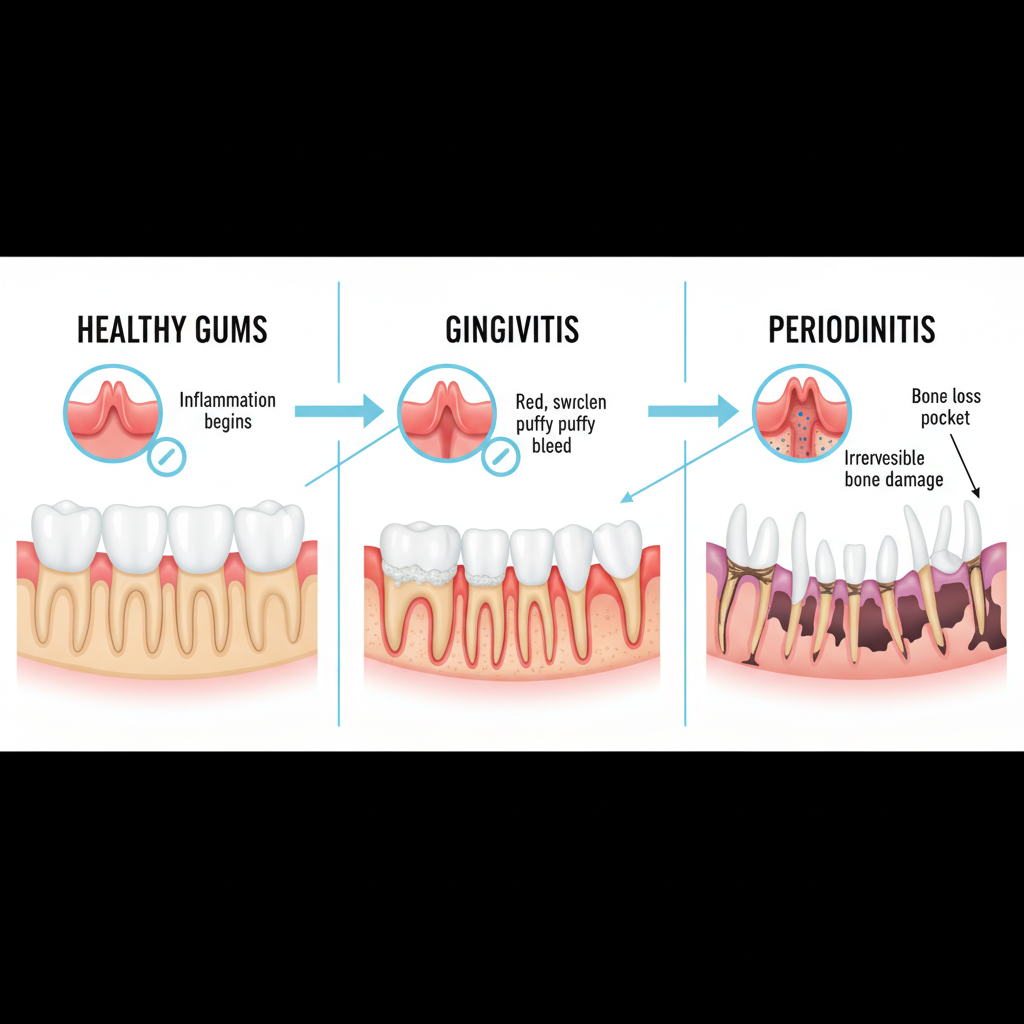
Bleeding gums, gum swelling, and persistent bad breath—these are early alarm bells most people ignore until it’s too late. Gum disease doesn’t wait: what starts as a little redness can snowball into tooth loss and bone damage. If you’re reaching for a mouthwash, the real question is: Are you using the right one for your stage of gum disease?
The Gum Disease Journey: Why One Mouthwash Doesn’t Fit All
Most people think all mouthwashes are the same, but the truth is, key ingredients and formulas matter hugely depending on whether you’re facing early gingivitis, creeping periodontitis, or maintaining after a deep dental cleaning. Here’s how to match your rinse to your needs—for real results, not empty promises.
Stage 1: Early Bleeding & Swollen Gums (Gingivitis)
Symptoms: Red, puffy gums that bleed when brushing or flossing. Bad breath creeping in. No bone loss yet—but don’t relax, because this stage can be reversed if you act fast.

What Mouthwash Can and Can’t Do: At this stage, a targeted antibacterial rinse can help reduce bacteria and inflammation while you step up your brushing and flossing game. But mouthwash alone won’t fix the problem—consistent oral hygiene is key.
- Crest Pro-Health Gum and Breath Purify Mouthwash — Alcohol-free, contains cetylpyridinium chloride (CPC), clinically proven to target bacteria at the gumline, reduce redness and swelling. Typical price: $6–$9 (500ml)[1][4].
- LISTERINE Clinical Solutions Gum Health — Infused with zinc, designed to kill germs causing bleeding and inflammation. Claim: 3x healthier gums in 1 week (vs brushing alone). Price: $7–$11 (500ml)[2].
- TheraBreath Healthy Gums Oral Rinse — Contains CPC, fights gingivitis for 24 hours, gentle and alcohol-free. Price: $8–$12 (473ml)[1][4].
How to Use: Brush and floss thoroughly, then rinse with 20–30ml for a full 30 seconds, at least twice daily. Don’t eat or drink for 30 minutes after—let the actives work.
Pro Tip: Look for an alcohol-free formula if you have sensitive gums or dry mouth[3][5]. Mouthwash with essential oils (like eucalyptol or tea tree) or aloe vera can soothe irritation[3][5].
Stage 2: Early to Moderate Periodontitis (When Things Get Serious)
Symptoms: Persistent gum bleeding, pockets forming around teeth, maybe even loose teeth. Bone is starting to erode. This is the danger zone—mouthwash is now just a support tool, not a fix.
- Peridex (Chlorhexidine Gluconate 0.12%) — Prescription-only, gold standard for killing bacteria and controlling inflammation at this stage. Used short-term only (2–4 weeks), as long-term use can stain teeth[4][3]. Price: $14–$20 (473ml, via dentist prescription).
- Colgate Total Gum Health Mouthwash — Over-the-counter, gentle for sensitive gums, reduces bacteria and plaque. Price: $6–$10 (500ml)[5].
- Hydrogen peroxide rinses (ex: Crest Pro-Health Multi-Protection) — Antibacterial, helps control inflammation, safe for daily use with minimal staining[1][3].
How to Use: Follow all instructions from your dentist. Never substitute mouthwash for professional cleaning. Resume OTC antibacterial rinses for ongoing support after your course of chlorhexidine is done.

When Mouthwash Alone Isn’t Enough: If you have deep pockets, receding gums, or loose teeth, DIY is over. A dentist or periodontist must perform a deep cleaning (scaling and root planing). Delaying puts you at risk for permanent bone loss and tooth loss[3].
Stage 3: Post–Deep Clean Maintenance (Winning the Long Game)
After a professional gum cleaning, maintaining results is all about consistency and the right support products. Even if your gums feel ‘cured,’ the risk of relapse is real—bacteria love a comeback.
- LISTERINE Total Care Anticavity Mouthwash — 6-in-1 formula, contains fluoride to strengthen enamel, prevent decay, and support ongoing gum health. Price: $7–$12 (1L)[5].
- ACT Total Care Anticavity Fluoride Rinse — Helps prevent cavities while supporting healthy gums. Price: $5–$8 (532ml)[5].
- TheraBreath Healthy Gums Oral Rinse or natural/alcohol-free options — For sensitive mouths, help reduce inflammation and maintain a healthy gum line[1][3][5].
How to Use: Stick to your post-cleaning routine religiously: brush, floss, then rinse with the recommended amount. Visit your dentist for checkups every 3–6 months.
New Research & Trends: Natural mouthwashes with aloe vera, tea tree oil, and botanical extracts are gaining traction for gentle, effective maintenance, especially for those with ongoing sensitivity or who want to avoid harsh chemicals[3][5].

Avoid These Mistakes: When Mouthwash Fails You
- Using mouthwash in place of brushing and flossing (it’s NOT a shortcut)
- Ignoring persistent bleeding or pain—see a dentist after 2 weeks if symptoms don’t improve
- Choosing cosmetic-only rinses (they mask smell, but don’t kill bacteria or stop disease)
- Overusing prescription rinses like Peridex (can cause tooth staining and taste alteration)
Expert Tips: Max Your Mouthwash Game Today
- Always swish for the full 30 seconds—set a timer!
- Wait at least 30 minutes after rinsing before eating or drinking
- For sensitive gums, opt for alcohol-free formulas with soothing agents like aloe or essential oils
- If you smoke, your risk for gum disease is higher—choose antibacterial rinses and see your dentist more frequently
- Look for the CDA or ADA ‘Validated’ seal for proven efficacy[4]
Ready to Take Control? Don’t Wait for the Next Stage…
Thousands already regret waiting until gum disease got out of hand—don’t be one of them. Stock up now on the right rinse for your needs, but remember: mouthwash is a support act, not the main event. The real win comes from daily brushing, flossing, and regular dental visits. Scared by bleeding gums or loose teeth? Book a checkup today—your future smile depends on it.


